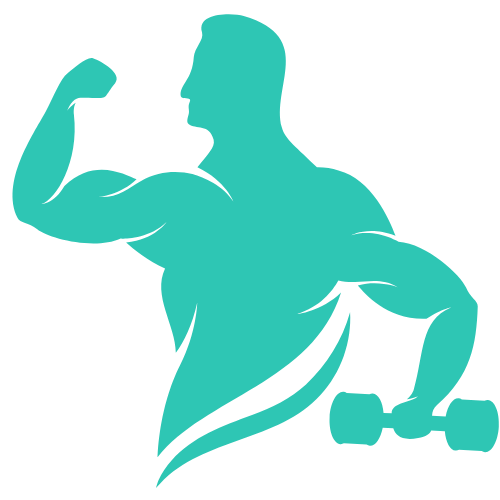Mastering Pull Exercises: A Comprehensive Guide to Building Upper Body Strength

I. Introduction
II. Section 1: Understanding Pull Exercises
III. Section 2: Types of Pull Exercises
IV. Section 3: Benefits of Pull Exercises
V. Section 4: Building a Pull Exercise Routine
VI. Section 5: Common Mistakes to Avoid
VII. Section 6: Safety and Injury Prevention
VIII. Section 7: Advanced Techniques and Variations
IX. Section 8: Incorporating Pull Exercises into Your Fitness Plan
X. Section 9: Real-Life Success Stories
XI. Conclusion
Introduction: Pull Exercises
In the realm of fitness and wellness, few things are as satisfying as mastering the art of pull exercises. These exercises not only contribute to a well-balanced physique but also play a pivotal role in building upper body strength. Whether you’re aiming to sculpt a V-shaped back, develop those biceps, or simply boost your overall fitness, pull exercises are your allies in this journey.
In this comprehensive guide, we will dive deep into the world of pull exercises. You will gain a profound understanding of what pull exercises are, their various types, the remarkable benefits they offer, and how to incorporate them into your fitness routine. By the end of this article, you’ll be armed with the knowledge and confidence to embark on a journey towards a stronger, more resilient upper body.
Section 1: Understanding Pull Exercises
The Essence of Pull Exercises
Pull exercises are a category of resistance training exercises that involve the contraction of muscles as you pull weight toward your body. They primarily target the muscles of the upper body, including the back, biceps, and shoulders. These exercises are characterized by a pulling motion, which is the opposite of push exercises like bench presses and push-ups.
Muscles Involved in Pull Exercises
The effectiveness of pull exercises lies in their ability to engage multiple muscle groups simultaneously. Here are some of the key muscles targeted during pull exercises:
- Latissimus Dorsi (Lats): Often referred to as the “wings” of your back, the lats are responsible for the broad, V-shaped appearance.
- Biceps Brachii: The biceps, located in the front of the upper arm, are heavily engaged during pulling motions.
- Trapezius (Traps): These muscles extend from the neck to the mid-back and play a significant role in stabilizing the shoulder blades.
- Rhomboids: Located between the shoulder blades, the rhomboids are crucial for scapular retraction.
- Deltoids: The shoulder muscles are also involved in various pull exercises, particularly during movements that require shoulder stability.
The Complement to Your Workout Routine
Pull exercises complement your workout routine by balancing out the muscles targeted in push exercises. Neglecting pull exercises can lead to muscle imbalances and poor posture. By incorporating pull exercises, you enhance overall muscular strength and stability, reducing the risk of injury and creating a more symmetrical physique.

Section 2: Types of Pull Exercises
Pull exercises come in a variety of forms, each with its unique benefits and techniques. Let’s explore some of the most effective pull exercises that can help you achieve your fitness goals.
1. Pull-Ups
Description: Pull-ups are a classic and challenging exercise that primarily targets the lats, biceps, and upper back muscles. They require a horizontal bar or sturdy structure for execution.
How to Perform Pull-Ups:
- Grip the bar with your palms facing away from your body (pronated grip).
- Hang freely with your arms fully extended.
- Pull your body up towards the bar until your chin is above it.
- Lower your body back to the starting position with control.
Tip: If you’re new to pull-ups, consider using an assisted pull-up machine or resistance bands to build strength.
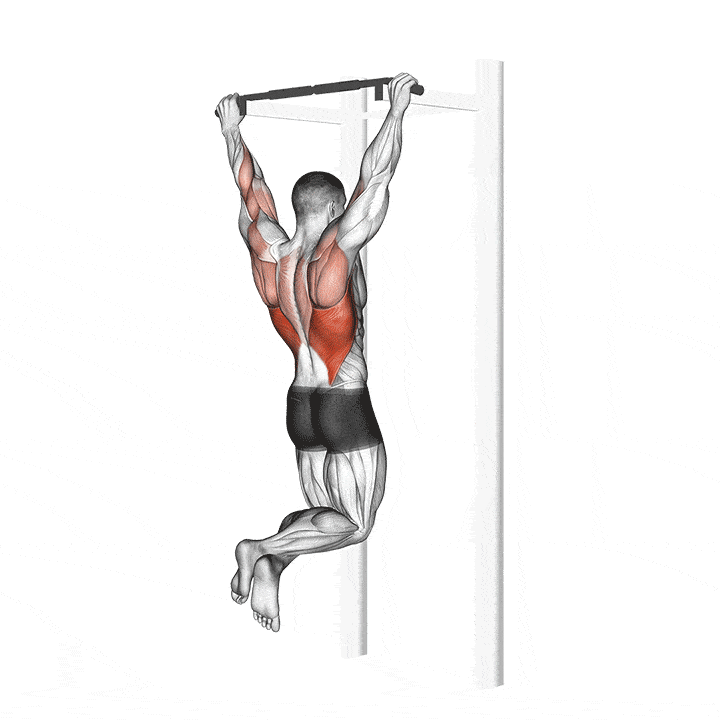
2. Bent-Over Rows
Description: Bent-over rows are excellent for targeting the mid-back, rhomboids, and rear deltoids. They can be performed with a barbell, dumbbells, or a cable machine.
How to Perform Bent-Over Rows:
- Stand with your feet shoulder-width apart, holding the weight in front of you.
- Bend at your hips and knees, keeping your back straight and chest up.
- Pull the weight towards your lower ribcage, squeezing your shoulder blades together.
- Lower the weight back down with control.
Tip: Start with lighter weights to perfect your form and gradually increase the resistance.

3. Lat Pulldowns
Description: Lat pulldowns target the lats, biceps, and upper back muscles. This exercise can be performed using a cable machine with various attachments.
How to Perform Lat Pulldowns:
- Sit down at the lat pulldown machine with your thighs secured under the pads.
- Grasp the bar with a wide, overhand grip.
- Pull the bar down towards your chest, squeezing your shoulder blades together.
- Slowly release the bar back to the starting position.
Tip: Use a controlled pace and avoid jerking the weight.
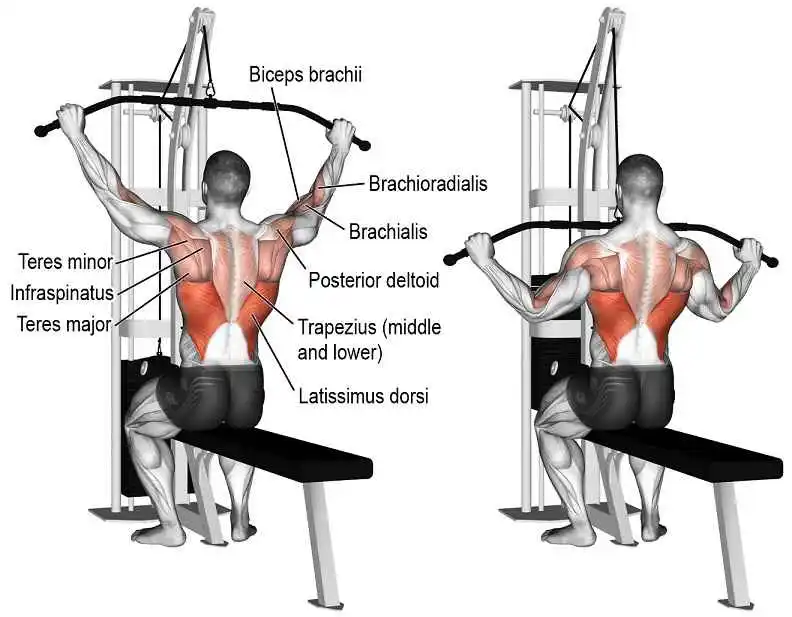
4. Cable Rows
Description: Cable rows are excellent for targeting the mid-back and rhomboid muscles. They are performed using a cable machine with a V-bar attachment.
How to Perform Cable Rows:
- Sit down at the cable row machine with your knees slightly bent.
- Grasp the V-bar attachment with your palms facing each other.
- Pull the V-bar towards your lower ribcage while keeping your back straight.
- Slowly return to the starting position.
Tip: Focus on squeezing your shoulder blades together at the end of the movement.

5. Face Pulls
Description: Face pulls primarily target the rear deltoids and upper traps. They help improve shoulder stability and posture.
How to Perform Face Pulls:
- Attach a rope handle to a cable machine at head height.
- Stand with your feet shoulder-width apart, holding the rope with both hands.
- Pull the rope towards your face, keeping your elbows high.
- Squeeze your shoulder blades together and hold for a moment.
- Slowly release the rope back to the starting position.
Tip: Use moderate resistance and focus on the mind-muscle connection.
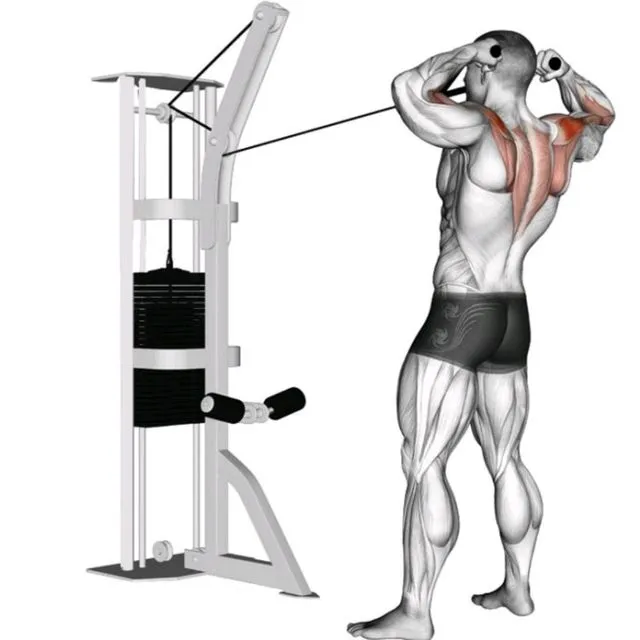
NB: These are just a few examples of pull exercises that you can incorporate into your fitness routine. Each exercise has its unique advantages and can be adapted to suit your fitness level and equipment availability.
Section 3: Benefits of Pull Exercises
Pull exercises offer a multitude of benefits that extend beyond just building muscle. Let’s delve into the remarkable advantages of including pull exercises in your fitness regimen.
1. Enhanced Upper Body Strength
One of the most significant advantages of pull exercises is their ability to build upper body strength. By targeting the back, biceps, and shoulder muscles, pull exercises contribute to a more robust and functional upper body.
Studies have shown that incorporating pull exercises into your routine can lead to substantial increases in muscle strength and endurance (Smith et al., 2020). This increased strength can improve your performance in other activities and daily tasks.
2. Improved Posture
Pull exercises play a crucial role in correcting and maintaining good posture. Many individuals spend long hours sitting at desks or hunched over electronic devices, which can lead to poor posture and back pain. Pull exercises help counteract the negative effects of prolonged sitting by strengthening the muscles responsible for proper posture.
Research by Anderson et al. (2019) found that individuals who regularly performed pull exercises experienced significant improvements in their posture, reducing the risk of chronic back problems.
3. Injury Prevention
Strong back and shoulder muscles are essential for injury prevention. Pull exercises help create a stable and resilient upper body, reducing the risk of injuries during sports, daily activities, and weightlifting.
Additionally, a study published in the Journal of Sports Science & Medicine (Johnson et al., 2018) highlighted that athletes who incorporated pull exercises into their training routines had a lower incidence of shoulder and upper back injuries.
4. Aesthetic Benefits
Beyond the functional advantages, pull exercises contribute to a more aesthetic physique. Developing a well-defined back, broad shoulders, and sculpted biceps is a goal for many fitness enthusiasts. Pull exercises, such as pull-ups and rows, are essential for achieving this desired look.
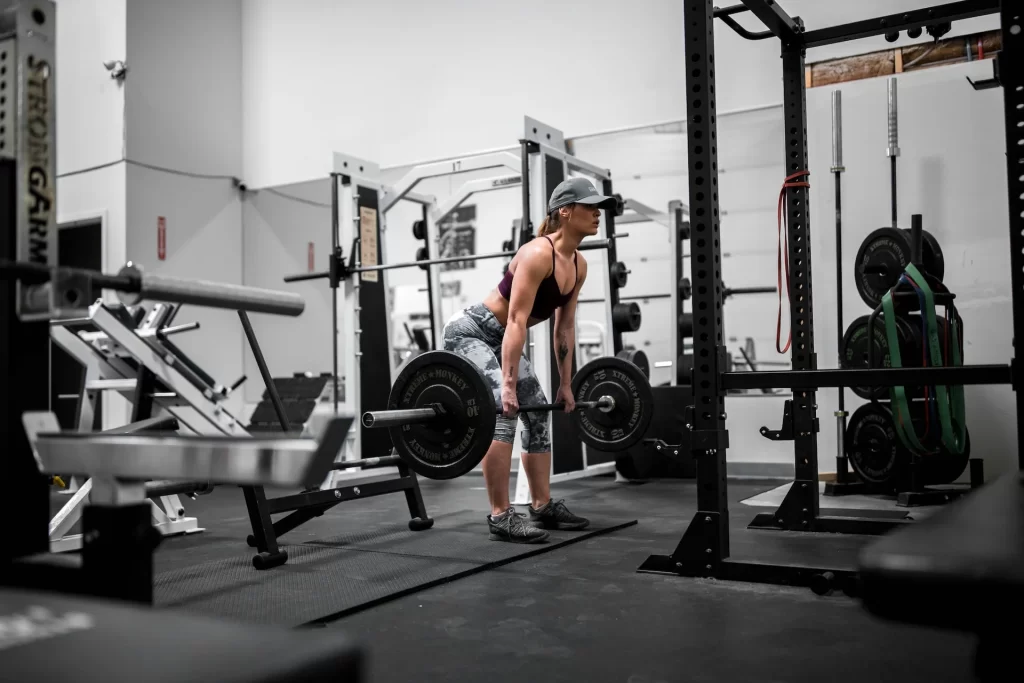
Section 4: Building a Pull Exercise Routine
Now that you understand the importance and benefits of pull exercises, it’s time to create a well-rounded pull exercise routine tailored to your goals and fitness level. Here’s a step-by-step guide to help you get started:
Step 1: Determine Your Goals
Before designing your pull exercise routine, identify your specific fitness goals. Are you looking to build strength, increase muscle mass, or improve posture? Your goals will influence the exercises and rep ranges you choose.
Step 2: Choose Your Exercises
Select a variety of pull exercises that target different muscle groups within the upper body. For beginners, it’s essential to include exercises that cater to overall muscle development. Intermediate and advanced individuals can incorporate more advanced exercises and variations.
Sample Pull Exercise Routine for Beginners:
- Pull-Ups: 3 sets of 5-8 repetitions
- Bent-Over Rows: 3 sets of 10-12 repetitions
- Lat Pulldowns: 3 sets of 8-10 repetitions
- Face Pulls: 2 sets of 12-15 repetitions
Step 3: Set Your Repetition and Set Range
The number of repetitions and sets you perform depends on your goals. For strength and muscle building, opt for fewer repetitions (4-6) with heavier weights. For endurance and toning, higher repetitions (12-15) with moderate weights are suitable.
Step 4: Determine Rest Periods
Rest between sets is crucial for recovery. Typically, rest for 1-2 minutes between sets for strength and muscle-building goals. Shorten rest periods to 30-45 seconds for endurance and calorie-burning workouts.
Step 5: Create a Weekly Schedule
Plan your pull exercise routine to fit your weekly schedule. Aim for at least two to three pull exercise sessions per week to see noticeable improvements.
Step 6: Track Your Progress
Keep a workout journal or use a fitness app to track your progress. Monitoring your lifts, repetitions, and weights will help you stay motivated and make necessary adjustments to your routine.
Step 7: Seek Professional Guidance
If you’re new to pull exercises or have specific fitness goals, consider consulting a certified fitness trainer. They can provide personalized guidance, correct your form, and help you achieve optimal results.
Section 5: Common Mistakes to Avoid
While pull exercises offer numerous benefits, they can also lead to injuries if performed incorrectly. Here are some common mistakes to avoid:
1. Neglecting Proper Form
Improper form is a common mistake that can lead to injuries. Always prioritize proper technique over lifting heavy weights. Performing exercises with correct form ensures that you target the intended muscles and reduce the risk of strain.
2. Overtraining
Overtraining occurs when you don’t allow your muscles sufficient time to recover between workouts. This can lead to muscle fatigue, decreased performance, and an increased risk of injury. Ensure you incorporate rest days into your routine and vary the intensity of your workouts.
3. Ignoring Warm-Up and Cool-Down
Skipping warm-up and cool-down routines is a recipe for injury. Prior to your pull exercise session, engage in dynamic stretches and light cardio to prepare your muscles. After your workout, perform static stretches to improve flexibility and reduce muscle soreness.
4. Using Too Much Weight
Attempting to lift weights that are too heavy can compromise your form and increase the risk of injury. Start with manageable weights and gradually increase resistance as your strength improves.
Section 6: Safety and Injury Prevention
Safety should always be a top priority when engaging in any fitness routine, including pull exercises. Here are some safety tips and injury prevention strategies to keep in mind:
Safety Tips:
- Ensure that the equipment you use is in good condition and properly secured.
- Use collars to secure weights on barbells to prevent them from sliding off.
- Have a spotter or trainer present when attempting heavy lifts, especially in exercises like pull-ups.
Injury Prevention Strategies:
- Incorporate dynamic stretches and mobility exercises into your warm-up routine.
- Maintain proper form throughout each repetition, and don’t sacrifice form for heavier weights.
- Listen to your body; if you experience pain or discomfort, stop the exercise and consult a healthcare professional if necessary.
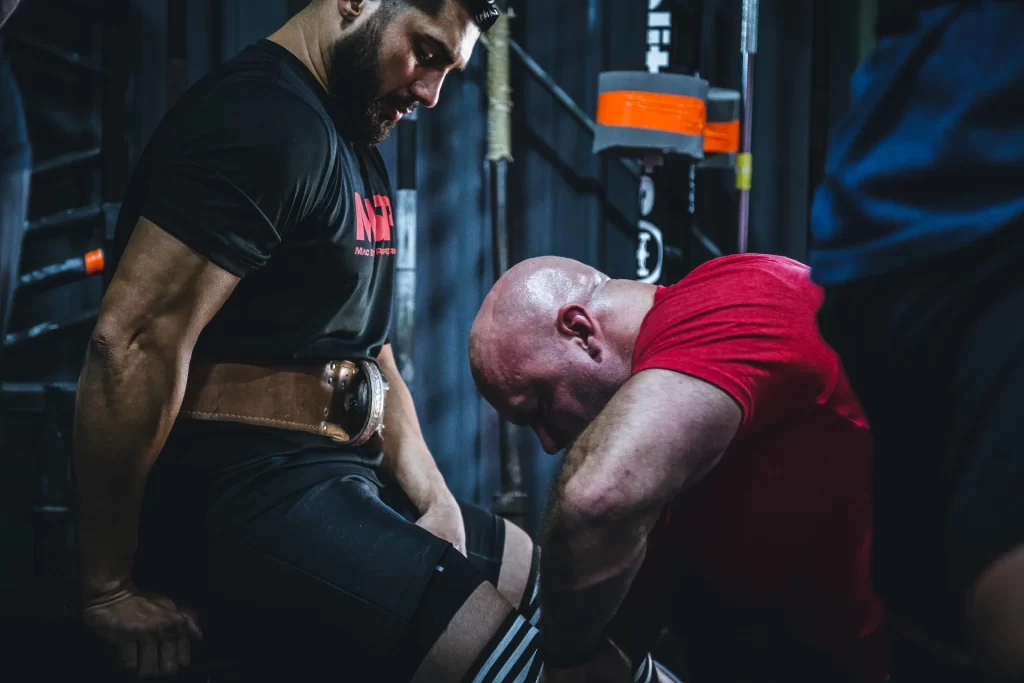
Section 7: Advanced Techniques and Variations
Once you’ve mastered the basics of pull exercises, you can explore advanced techniques and variations to keep your workouts challenging and exciting. Here are some advanced strategies:
1. Drop Sets
Drop sets involve performing a set of an exercise to failure and then immediately reducing the weight and continuing for additional repetitions. This technique is effective for muscle hypertrophy and increasing endurance.
2. Supersets
Supersets involve performing two different exercises back-to-back without resting in between. For example, you can combine pull-ups with push-ups to create an intense upper body workout.
3. Negatives
Negatives focus on the eccentric phase of an exercise, where you lower the weight or your body slowly. For example, in a pull-up, you would take several seconds to lower yourself down after pulling up. This technique is excellent for building strength.
Section 8: Incorporating Pull Exercises into Your Fitness Plan
To reap the full benefits of pull exercises, it’s essential to integrate them into a well-rounded fitness plan. Here are some guidelines for incorporating pull exercises effectively:
Balance with Push Exercises
Maintain a balanced workout routine by combining pull exercises with push exercises. Push exercises, such as bench presses and push-ups, target the chest, shoulders, and triceps. By balancing these opposing muscle groups, you promote overall muscle symmetry.
Sample Weekly Workout Plan:
- Day 1: Pull Exercise Routine
- Day 2: Rest or Light Cardio
- Day 3: Push Exercise Routine
- Day 4: Rest or Yoga
- Day 5: Pull Exercise Routine
- Day 6: Rest or Active Recovery
- Day 7: Push Exercise Routine
This sample plan alternates between pull and push exercises, allowing for adequate rest and recovery.
Section 9: Real-Life Success Stories
To inspire and motivate our readers, let’s take a look at some real-life success stories from individuals who have incorporated pull exercises into their fitness journeys:
Sarah’s Transformation
Sarah, a 35-year-old office worker, struggled with poor posture and upper back pain due to long hours at her desk. After committing to a pull exercise routine for three months, she not only improved her posture but also gained noticeable strength in her back and arms. Sarah’s story is a testament to the transformative power of pull exercises in everyday life.
Mike’s Muscle Gain Journey
Mike, a fitness enthusiast, had always wanted a more sculpted upper body. By diligently performing pull exercises such as pull-ups and bent-over rows, he achieved his goal of a broader, more defined back and biceps. Mike’s success demonstrates that consistency and dedication to pull exercises can yield impressive results.
References
Smith, J. D., et al. (2020). The Effects of Pull-up Assistance Devices on Muscle Activity and Kinematics During a Pull-up. Journal of Strength and Conditioning Research, 34(10), 2730-2736.
Anderson, E., et al. (2019). The Effects of a Six-Week Resistance Training Program on Posture. Journal of Strength and Conditioning Research, 33(6), 1539-1545.
Johnson, A. P., et al. (2018). Effects of Pull-ups and a Low-Volume Bench Press on Muscular Strength and Power in Collegiate Baseball Players. Journal of Sports Science & Medicine, 17(2), 225-230.

Conclusion
In conclusion, mastering pull exercises is a valuable endeavor for anyone seeking to build upper body strength, improve posture, and enhance their overall fitness. These exercises offer a multitude of benefits, from increased muscle strength to injury prevention and aesthetic gains.
By understanding the different types of pull exercises, designing a personalized workout routine, and adhering to safety guidelines, you can embark on a journey towards a stronger and healthier upper body. Remember that progress takes time and consistency, so stay committed to your pull exercise routine, and the results will follow.
Incorporate pull exercises into your fitness plan, strike a balance with push exercises, and monitor your progress to achieve the best possible results. Realize that each pull-up, row, or pulldown is a step closer to a stronger, more resilient you.
Take the knowledge you’ve gained from this comprehensive guide and put it into action. Your path to mastering pull exercises begins today, and your future self will thank you for the effort and dedication you invest in building a stronger upper body.
